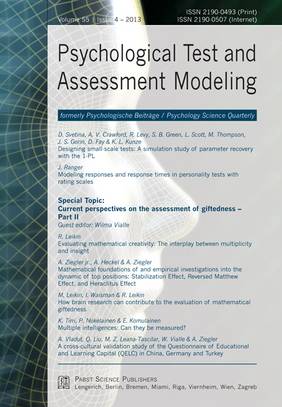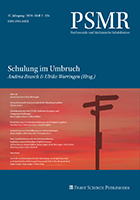Psychology Test and Assessment Modeling publishes in its current issue (4/2013) five new papers reg. the assessment of giftedness, edited by Wilma Vialle (University of Wollongong). The authors trust that the papers in the current issue and in Psychology Test and Assessment Modeling 3/2013 provide a stimulus for ongoing interactions and commentary on the nature of giftedness and its measurement.
The first paper, entitled "Evaluating mathematical creativity: The interplay between multiplicity and insight by Leikin (2013), like Kontoyianni et al. (2013), explores the domain of mathematics. This conceptual paper proposes a model to differentiate among levels of mathematical creativity through two dimensions, which she labels multiplicity (divergent thinking) and insight (convergent thinking). The model was tested on a sample of four groups of students differentiated on the basis of general giftedness (gifted; non-gifted) and excellence in Mathematics (excellent; non-excellent).
The second paper, "Mathematical foundations of and empirical investigations into the dynamic of top positions: Stabilization effect, reversed Matthew effect, and Heraclitus effect, by Ziegler, Heckel, and Ziegler (2013) analyses the highest levels of performance (top positions) through the lens of mathematics. The authors detail three propositions - the stabilization effect, the reversed Matthew effect, and the Heraclitus effect - related to outstanding performance, which they empirically illustrate through the domains of chess and soccer.
The third paper entitled "How brain research can contribute to the evaluation of mathematical giftedness by Leikin, Waisman, and Leikin (2013) also targets mathematical giftedness. The paper shares some assumptions with the earlier paper by Leikin (2013) in differentiating students on the basis of general giftedness and excellence in mathematics. In this paper, however, the researchers draw on neurocognitive approaches to identify mathematical giftedness in schoolchildren.
The fourth paper, "Multiple Intelligences: Can they be measured?, by Tirri, Nokelainen, and Komulainen (2013) details the development and validation of a self-report instrument to measure the intelligences identified by Gardner (1983) in his theory of Multiple Intelligences. In the paper, Tirri and her colleagues report on the psychometric validation of the measurement instrument with an empirical sample of approximately 400 students.
The final paper entitled "A cross-cultural validation study of the Questionnaire of Educational and Learning Capital (QELC) in China, Germany and Turkey by Vladut, Liu, Leana-Tascila, Vialle, and Ziegler (2013) also reports on the validation of an instrument for the measurement of giftedness. The theoretical basis for the instrument is Zieglers (2005) actiotope model of giftedness and it comprises ten forms of educational and learning capital associated with outstanding performance. Vladut and her colleagues validated the instrument with samples from three countries.
Psychological Test and Assessment Modeling 4/2013






















